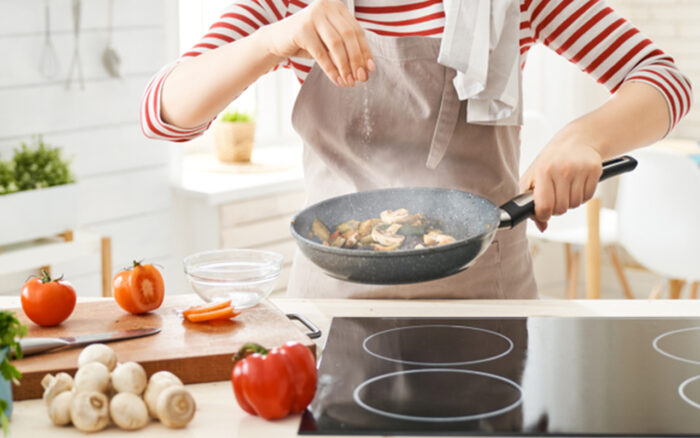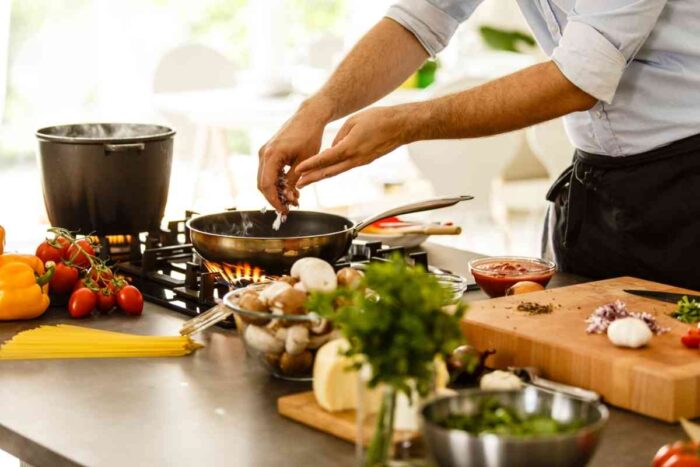
Cooking is an essential life skill that can be both enjoyable and rewarding. If you’re a student or a beginner in the kitchen, mastering basic cooking techniques is crucial to your culinary success. Knowing how to properly prepare, cook, and season food can take your meals from average to exceptional, impressing even the most discerning palates.
In this article, we will explore some tips and tricks for mastering basic cooking techniques that will help you elevate your cooking game. So, grab your apron, roll up your sleeves, and let’s get started on your culinary journey!
Understanding 7 Cooking Techniques

The importance of mastering the different methods used in the kitchen cannot be overemphasized. They are meant to improve the quality of meals, enhance flavors, and ensure that the food is safe to eat. There are several basic cooking techniques every cook must know, some of them are:
1. Sautéing
This term, taken from the French, means cooking food in a small amount of oil or fat over high heat. This technique is ideal for cooking vegetables, meats, and seafood that require quick cooking times.
2. Roasting
This technique involves cooking food in an oven or on a spit over an open flame. It is ideal for cooking large cuts of meat, poultry, and vegetables.
3. Grilling
This is the act of cooking food on a grill or over an open flame. This technique is ideal for cooking meats, seafood, and vegetables.
4. Boiling
Boiling involves cooking food in boiling water. It is ideal for cooking pasta, vegetables, and grains. For example, cooking a delicious spanish white rice involves this technique as one of the first steps.
5. Steaming
Boiling water that produces steam and its vapor cooks the food. This technique is ideal for cooking vegetables, seafood, and dumplings.
6. Braising
Braising involves cooking food in a small amount of liquid, typically over low heat. This technique is ideal for cooking tough cuts of meat, such as beef brisket or pork shoulder.
7. Deep-Frying
With this technique, food is quickly cooked and submerged in a large volume of oil over high heat. This technique is ideal for cooking vegetables, meats, and seafood, and gives them a crispy, crunchy texture.
With these basic techniques, you can create a variety of dishes with different textures, flavors, and aromas, making every meal a unique and enjoyable experience.
Preparing for Cooking

Here are some important tips to keep in mind when getting ready to start preparation.
Importance of Preparation
First and foremost, you need to gather all the necessary ingredients ahead of time, as it’ll be too ineffective to frantically search for a missing ingredient or run to the store in the middle of cooking.
Additionally, properly preparing your ingredients can ensure that they cook evenly and that your dish turns out perfectly.
Kitchen Tools and Equipment Needed for Cooking
Before you start cooking, it’s important to make sure that you have all the necessary kitchen tools and equipment on hand. This can include things like knives, cutting boards, measuring cups and spoons, mixing bowls, pots and pans, and cooking utensils.
Depending on the recipe you’re making, you may also need specialized equipment like a food processor or stand mixer.
4 Tips for Organizing and Preparing Ingredients
When it comes to processing ingredients, there are a few things you can do to make it easier and more efficient.
- First, read through the recipe carefully and gather everything together.
- Then measure out the quantities you’ll need for the recipe. This can help ensure that you don’t accidentally leave out an ingredient or use the wrong amount.
- Next, chop and prep your ingredients as needed. For example, if the recipe calls for diced onions, take the time to chop them evenly so that they cook evenly.
- Make sure to keep your work area clean and organized. This can help prevent cross-contamination and ensure that you don’t accidentally use the wrong ingredient.
You can also save time in the process by prepping ingredients in advance, such as washing and chopping vegetables the night before you plan to cook.
And remember, keeping your work area clean and organized you can save time and create delicious meals with ease.
Mastering Basic Cooking Techniques

Cooking can be an intimidating task, especially for beginners. However, mastering basic cooking techniques is essential to elevate your culinary skills and make delicious meals. Here are some step-by-step instructions and common mistakes to avoid to help you master these basic cooking techniques.
Basic Technique 1 ─ Sautéing
Here’s how to do it in four simple steps:
- Heat a skillet over medium-high heat.
- Add oil or butter to the skillet.
- Once the oil or butter is hot, add your ingredients and cook until they’re browned and crispy.
- Stir occasionally to prevent sticking.
Common mistake: Overcrowding the skillet, which leads to steaming instead of sautéing. Make sure to cook in batches if necessary.
Basic Technique 2 ─ Roasting
You will use dry heat to cook ingredients in the oven. Here’s how to do it:
- Preheat your oven to the desired temperature.
- Season your ingredients with salt, pepper, and any other desired seasonings.
- Place the ingredients on a baking sheet and bake until they’re browned and
- cooked through.
- Flip the ingredients halfway through cooking to ensure even browning.
Common mistake: Using a baking sheet that’s too small, which leads to overcrowding and steaming. Use a larger baking sheet or cook in batches if necessary.
Basic Technique 3 ─ Boiling
Learn to cook ingredients in boiling water in 3 easy steps:
- Bring a pot of water to a boil.
- Add your ingredients and cook until they’re tender.
- Remove the ingredients from the water using a slotted spoon or strainer.
Common mistake ─ Overcooking ingredients, which leads to a mushy texture. Make sure to set a timer and check for doneness frequently.
In short, mastering basic cooking techniques is something that can be learned in a relatively short amount of practice. Now that you know these simple step-by-step instructions and the most common mistakes to avoid, take your time in the kitchen to create delicious dishes that are sure to impress your family and friends.








